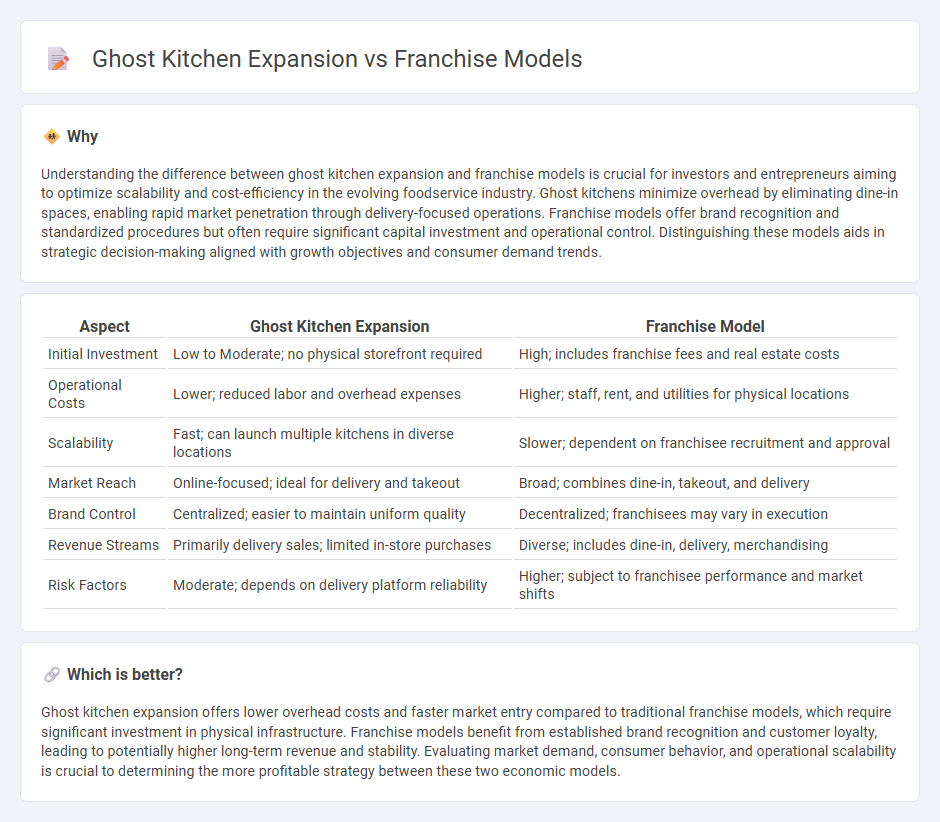
Ghost kitchen expansion offers a cost-effective alternative to traditional franchise models by eliminating dine-in space and reducing overhead expenses, enabling rapid scalability and lower startup costs. Franchise models, while requiring significant capital and operational control, benefit from established brand recognition and structured support systems enhancing market penetration. Explore detailed comparisons to understand which model best suits evolving market demands and investment strategies.
Why it is important
Understanding the difference between ghost kitchen expansion and franchise models is crucial for investors and entrepreneurs aiming to optimize scalability and cost-efficiency in the evolving foodservice industry. Ghost kitchens minimize overhead by eliminating dine-in spaces, enabling rapid market penetration through delivery-focused operations. Franchise models offer brand recognition and standardized procedures but often require significant capital investment and operational control. Distinguishing these models aids in strategic decision-making aligned with growth objectives and consumer demand trends.
Comparison Table
| Aspect | Ghost Kitchen Expansion | Franchise Model |
|---|---|---|
| Initial Investment | Low to Moderate; no physical storefront required | High; includes franchise fees and real estate costs |
| Operational Costs | Lower; reduced labor and overhead expenses | Higher; staff, rent, and utilities for physical locations |
| Scalability | Fast; can launch multiple kitchens in diverse locations | Slower; dependent on franchisee recruitment and approval |
| Market Reach | Online-focused; ideal for delivery and takeout | Broad; combines dine-in, takeout, and delivery |
| Brand Control | Centralized; easier to maintain uniform quality | Decentralized; franchisees may vary in execution |
| Revenue Streams | Primarily delivery sales; limited in-store purchases | Diverse; includes dine-in, delivery, merchandising |
| Risk Factors | Moderate; depends on delivery platform reliability | Higher; subject to franchisee performance and market shifts |
Which is better?
Ghost kitchen expansion offers lower overhead costs and faster market entry compared to traditional franchise models, which require significant investment in physical infrastructure. Franchise models benefit from established brand recognition and customer loyalty, leading to potentially higher long-term revenue and stability. Evaluating market demand, consumer behavior, and operational scalability is crucial to determining the more profitable strategy between these two economic models.
Connection
The rapid expansion of ghost kitchens leverages franchise models to scale efficiently by minimizing overhead costs and streamlining operations. Franchise systems provide a proven framework for replicating successful virtual restaurant brands across multiple locations, enhancing market penetration. This synergy accelerates revenue growth and optimizes asset utilization in the evolving digital food economy.
Key Terms
Revenue Sharing
Franchise models typically involve revenue sharing where the franchisor earns a percentage of the franchisee's sales, ensuring consistent cash flow tied directly to operational performance. Ghost kitchen expansions leverage a more flexible revenue-sharing approach, often collaborating with multiple brands while minimizing overhead costs and maximizing delivery efficiency. Explore the dynamics of revenue sharing in these models to optimize growth strategies for your food business.
Asset Light Operations
Franchise models enable rapid expansion by leveraging franchisees' capital, reducing the franchisor's asset burden and operational risks, which aligns well with asset-light strategies. Ghost kitchens minimize real estate and front-of-house costs by operating delivery-only food preparation facilities, presenting a scalable, asset-light alternative to traditional restaurant expansion. Explore how these models revolutionize the food service industry through asset-light operations and strategic growth.
Market Penetration
Franchise models leverage established brand recognition and local operators to achieve rapid market penetration, benefiting from proven business systems and shared marketing resources. Ghost kitchens focus on cost-efficient expansion by minimizing overhead costs and optimizing delivery-only food production, enabling quick entry into densely populated urban markets. Explore the strategic advantages and challenges of each model to determine the best fit for your market penetration goals.
Source and External Links
Types of Franchise Models Explained - Details the conversion, master, and investment franchise models, explaining how each operates, from joining established networks as a franchisee to managing sub-franchisees as a master, or simply investing as a passive financial backer.
Franchising Business Models Explained - Focuses on the FOFO (Franchise Owned Franchise Operated) model, where franchisees own and operate their outlets following franchisor guidelines, and briefly mentions less common models like COCO (Company Owned Company Operated) and COFO (Company Owned Franchise Operated).
Types of Franchise Business Models - Outlines four main franchise structures: COCO (company-owned, company-operated), COFO (company-owned, franchise-operated), FOCO (franchise-owned, company-operated), and FOFO (franchise-owned, franchise-operated), highlighting their distinct ownership and operation dynamics.
 dowidth.com
dowidth.com